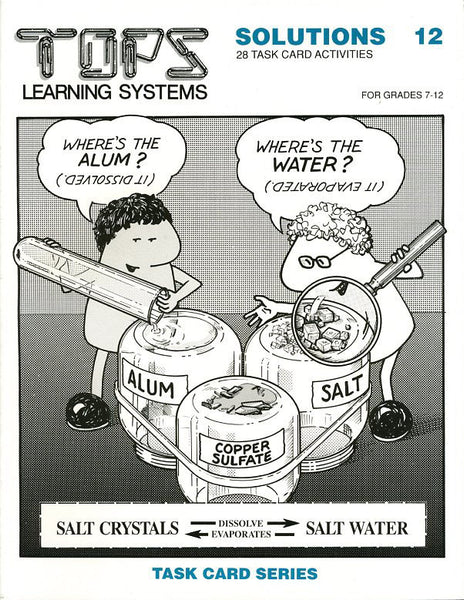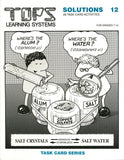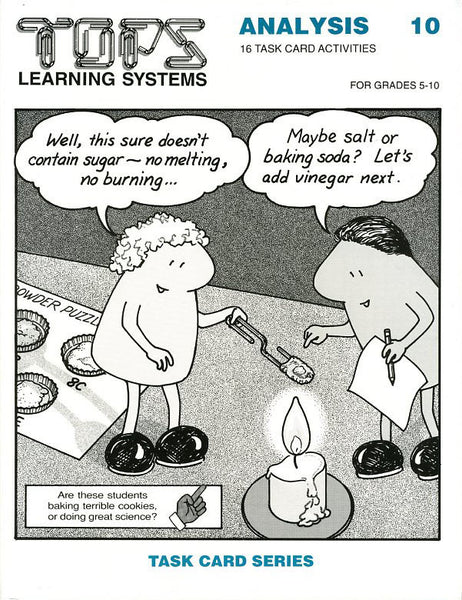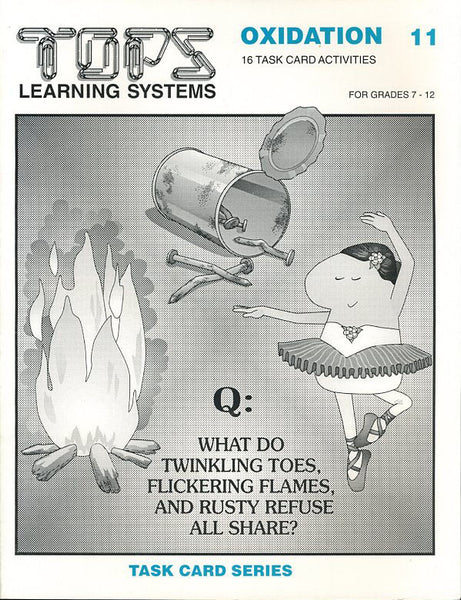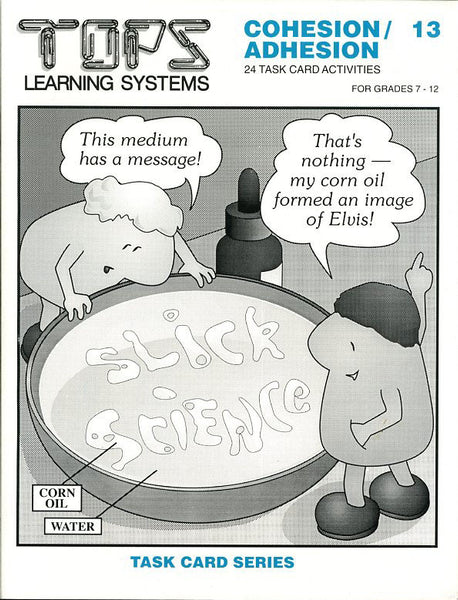#12 Solutions (grades 6-10)
Regular price $20.95
Soft-bound, 72 page book, 28 reproducible task cards, full teaching notes.
Begins with corn starch. Mixed cold, it forms a coarse suspension that clears by filtering or settling. When boiled it forms both a cloudy colloidal suspension and a clear true solution. Apply concepts and vocabulary learned here to a series of tasks that clean muddy water: Alum coagulates the clay, chlorination bleaches all traces of food coloring, but only distillation makes it pure. Use common salts to study about crystals, concentration and saturation, rates of dissolving and limits of solubility.
Solutions Supplies - book must be purchased separately
WE SUPPLY seven key chemicals: 10 mL Alum, 10 mL Copper Sulfate, 20 mL Rock Salt, 20 mL Epsom Salt, 20 mL Calcium Acetate, 20 mL Sodium Thiosulfate and 1 dropper bottle of Iodine. YOU SUPPLY everything else.
Click here for a complete list of materials and convenient shopping.
paper towels, scissors, laboratory filters, corn starch, granulated sugar, alum, fine-grained table salt, baking soda, copper sulfate, rock salt, Epsom salt, baby food jars (or small beakers), water, iodine, rubbing alcohol, chlorine bleach, mineral oil, liquid detergent, India ink, vinegar, distilled water, eyedroppers non-dairy creamer pepper, test tubes, magnifying glasses, paper drinking cups, metric rulers, aluminum foil, rice, powdered milk, flour, clear tape, graduated cylinders, 10 mL, seltzer tablets, sugar cubes, microscope slides, facial tissues, microscopes, rubber bands scouring cleanser, index cards, paper punch tools, plastic straws, clock with second hand, gram balances (instruments constructed in #05 Weighing are suitable), calculators, Pyrex beakers, clothespins, permanent markers, bottle calcium acetate, sodium thiosulfate- Lesson 1: To compare the filtering capacity of soft and hard paper towels. To relate the porosity of filter paper to the size of particles in suspension.
- Lesson 2: To clear a suspension by settling and by filtering. To understand how these processes work in nature.
- Lesson 3: To relate the clarity of a solution to the size of particles it contains. To examine how saliva breaks down starch into simple sugars.
- Lesson 4: To compare and contrast a coarse suspension, colloidal dispersion and true solution. To define and use basic vocabulary.
- Lesson 5: To clear a mixture of soil and water by settling and filtration. To observe how soil particles tend to sort by size.
- Lesson 6: To coagulate a colloidal clay dispersion in water with aluminum salt so it may be cleared by filtration.
- Lesson 7: To treat water with chlorine bleach. To understand that this kills bacteria but fails to remove other dissolved toxins.
- Lesson 8: To build a simple solar distillation apparatus that will purify a true solution.
- Lesson 9: To understand the role of refracted light in revealing the interface between phases of different densities. To observe how detergent forms an emulsion in oil.
- Lesson 10: To understand why salt and water lose volume when mixed together.
- Lesson 11: To observe how light bends as alcohol dissolves in water. To explain the reduction in volume as these liquids form a solution.
- Lesson 12: To review three purifying techniques studied thus far. To distinguish between coarse suspensions, colloidal dispersions and true solutions.
- Lesson 13: To discover how temperature influences the rate of dissolving. To distinguish between heterogeneous and homogeneous mixing.
- Lesson 14: To geometrically demonstrate how the surface area of a solute increases as its crystals are subdivided into smaller particles. To understand why pulverizing the solute accelerates its dissolving rate.
- Lesson 15: To recognize that solvents have a saturation point beyond which more solute will not readily dissolve.
- Lesson 16: To compare the dissolving capacity of saturated salt water with fresh water.
- Lesson 17: To examine rapid crystal growth on a microscope slide. To recognize the basic repeating pattern.
- Lesson 18: To grow crystals from saturated salt solutions. To identify the basic repeating crystal shapes.
- Lesson 19: To analyze various sources of drinking water for the presence of dissolved minerals.
- Lesson 20: To model equilibrium conditions in a saturated solution. To appreciate, on a molecular level, the dynamic nature of saturated solutions.
- Lesson 21: To graph how rock salt dissolves as a function of time. To observe that the rate of dissolving slows as the solution approaches its point of saturation.
- Lesson 22: To become familiar with various units of concentration. To graph, in standard units, how a dissolving salt approaches its limit of solubility as a function of time.
- Lesson 23: To test various salts for water of hydration.
- Lesson 24: To quantitatively determine how much water of hydration is held by Epsom salt. To compare this experimental value with theoretical values based on its gram formula weight.
- Lesson 25: To observe how solubility changes with the nature of the solute and the temperature of the solvent. To describe these changes in both qualitative and quantitative terms.
- Lesson 26: To read and interpret a solubility graph. To predict the solubility of salts in water at specific temperatures.
- Lesson 27: To recognize that the solubility of some solutes in water decreases with increasing temperature.
- Lesson 28: To make a supersaturated solution of sodium thiosulfate that recrystallizes with the addition of a seed crystal to a more stable form. To observe that heat is released as the solution stabilizes.
TEACHING Standards
These 28 Task Cards promote excellence in science teaching by these NSES criteria:Teachers of science...
A: ...plan an inquiry-based science program. (p. 30)
B: ...guide and facilitate learning. (p. 32)
C: ...engage in ongoing assessment of their teaching and of student learning. (p. 37)
D: ...design and manage learning environments that provide students with the time, space, and resources needed for learning science. (p. 43)
CONTENT Standards
These 28 Task Cards contain fundamental content as defined by these NSES guidelines (p. 109).• Represent a central event or phenomenon in the natural world.
• Represent a central scientific idea and organizing principle.
• Have rich explanatory power.
• Guide fruitful investigations.
• Apply to situations and contexts common to everyday experiences.
• Can be linked to meaningful learning experiences.
• Are developmentally appropriate for students at the grade level specified.
Unifying Concepts and Processes
NSES Framework: Systems, order, and organization • Evidence, models and explanation • Constancy, change, and measurement • Evolution and equilibrium • Form and functionCore Concepts/Processes: The diminishing size of dissolved particles determines the nature of suspensions, colloidal dispersions and true solutions.
Science as Inquiry (content standard A)
NSES Framework: Identify questions that can be answered through scientific investigations. • Design and conduct a scientific investigation. • Use appropriate tools and techniques to gather, analyze, and interpret data. • Develop descriptions, explanations, predictions, and models using evidence. • Think critically and logically to connect evidence and explanations. • Recognize and analyze alternative explanations and predictions. • Communicate scientific procedures and explanations. • Use mathematics in all aspects of scientific inquiry.Core Inquiries: Inquire into the nature of solutions. Evaluate basic techniques for purifying water.
Physical Science (content standard B)
NSES Framework:Properties and changes of properties in matter • Chemical reactions • Interactions of energy and matterCore Content:Coarse and fine suspensions • Dispersions • True solutions • Saturation • Supersaturation • Equilibrium • Solubility rate • Solubility variables • Water of hydration

